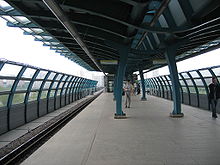- Medium-capacity rail transport system
-
In rail transport, a medium-capacity system (MCS) is a non-universal term coined to differentiate an intermediate system between light rail and heavy rail. The concept is similar to Light Metro, seen in European countries (see section Variants of the term). A medium-capacity system is proposed when an area requires a rapid transit service but the predicted ridership falls between the gap of the other two rail tiers. In contrast with light rail, a medium-capacity system is usually running on an exclusive right-of-way. Furthermore, the distance between stations is much longer. An MCS may also be a branch connection to another mode of a heavy-capacity transportation system, such as an airport or the main route of a metro network.
Contents
Open
Suggested system
 Elevated platform of Ulitsa Gorchakova Station, Moscow Metro. Its structure shares some similarity to stations of Ma On Shan Line
Elevated platform of Ulitsa Gorchakova Station, Moscow Metro. Its structure shares some similarity to stations of Ma On Shan Line
The definition of a medium-capacity system varies due to its non-standardization. This can exist even within a relatively small country. For example, the Taiwan Ministry of Transportation and Communications states that each train can board around 6,000 to 20,000 passengers per hour per direction (p/h/d).[1] However, the Taiwan Department of Rapid Transit Systems (TCG) suggests an MCS has a capability of boarding around 20,000 to 30,000 p/h/d.[2]
The train may have a shorter configuration than the standard metro system, usually 3 to 6 cars, allowing shorter platforms to be built. Rather than using steel wheels, rubber-tyred metro technology, such as the VAL system used on the Taipei Metro, is sometimes recommended, due to its low running noise, as well as the ability to climb steeper grades and turn tighter curves, thus allowing more flexible alignments.
Variants of the term
 Train on the Copenhagen Metro
Train on the Copenhagen Metro
The term may vary in different countries. In Russia, the "Light Metro" (Лёгкое метро) Л1 - Butovskaya Line has been built to serve the residents of outer Moscow. This line connects the passengers with the main routes of Moscow Metro. VAL, the French rubber-tyred fully automated metro system, also applies the term "Light Metro" to define its capacity (up to 30,000 p/h/d.[3]) These can thus also be categorized into the medium-capacity system family.
Advantages and Disadvantages
Light metros can generally operate faster than heavy-rail rapid transit systems, due to shorter dwell times at stations and the faster acceleration/deceleration of lighter trains. For example, express trains on the New York City Subway are about as fast as the Vancouver SkyTrain, but express trains skip most stops on lines where they operate.
Medium-capacity systems have a latent weakness in that as the service district's population increases, the increased transportation demand might create bottlenecks. But it is difficult to extend the platforms once in operation, since it must be done without interfering with traffic, especially for underground railway systems. Some railway planners[who?] may make provisions such as longer platforms than necessary so that they will be capable, in future, of accommodating trains with more cars or longer cars. The Taipei Rapid Transit System, for example, left extra space for two extra cars in all Wenshan Line and Neihu Line stations. The Ma On Shan Line in Hong Kong has even applied the railway standard (with less car configuration) for a possible link with the other existing heavy rail route without reconstructing the current system.
Examples
- Ankara -
- Ankaray light metro (3-car config, 77 metres length).
- Bangkok -
- BTS Skytrain (3-car config.)
- Busan -
- Busan-Gimhae Light Rail Transit (2-car config.)
- Busan Subway Line 4 (6-car config. rubber tires)
- Copenhagen -
- Copenhagen Metro (3-car config, 39 metres length).
- Guangzhou -
- Line 3 (began with 3-car configuration, changed to 6-car in 2010)
- Hong Kong -
- Ma On Shan Line (4-car config.)
- South Island Line (planning, rubber-tyred)[4]
- Kwun Tong Line (had in the past run with 4-car and 6-car configuration)
- Istanbul -
- Istanbul Hafif Metro (4-car config).
- Kuala Lumpur -
- Kelana Jaya Line: (Mixed 2-car, 4-car fleet config)
- London -
- Los Angeles -
- Los Angeles County Metro Rail (Green Line)
- New York -
- Manila
- Russia -
- Moscow Metro: Л1 - Butovskaya Line (6.7k pph, 3~4-car config.)
- Shanghai -
- Line 5, Shanghai Metro
- Line 6, Shanghai Metro
- Singapore -
- Singapore MRT: Circle MRT Line (3 car config.)[5]
- Taipei -
- Taipei Rapid Transit System:
- Wenshan Line (TRTS) (rubber-tyred, 4-car config.)
- Neihu Line (TRTS) (Extension of the Wenshan line)
- Taipei Rapid Transit System:
- Toronto -
- Scarborough RT (part of Toronto Subway and RT)
- Vancouver -
- Wuhan -
- Line 1, Wuhan Metro(4 car config.)
References
- ^ "Transportation term definition" (in Chinese). Ministry of Transportation and Communications (MOTC). http://www.motc.gov.tw/motchypage/hypage.cgi?HYPAGE=stat13.asp&catid=10. Retrieved 2008-06-30.
- ^ "Comparison between high capacity and medium capacity systems" (in Chinese). Taiwan Department of Rapid Transit Systems, TCG. http://www.dorts.gov.tw/tech/cyclo2.asp?t=??%2009:09:59. Retrieved 2008-06-30.[dead link]
- ^ "VAL and NeoVAL". Siemens TS. Archived from the original on 2008-06-26. http://web.archive.org/web/20080626110428/http://www.transportation.siemens.com/ts/en/pub/products/mt/products/val.htm. Retrieved 2008-06-30.
- ^ MTR South Island Line (east section) official construction plan
- ^ Circle Line On Track For Completion
External links
- Urban rail transit definitions by the USA's Transportation Research Board and the American Public Transportation Association
- (Jane's) Urban Transit Systems
Categories: - Ankara -
Wikimedia Foundation. 2010.


